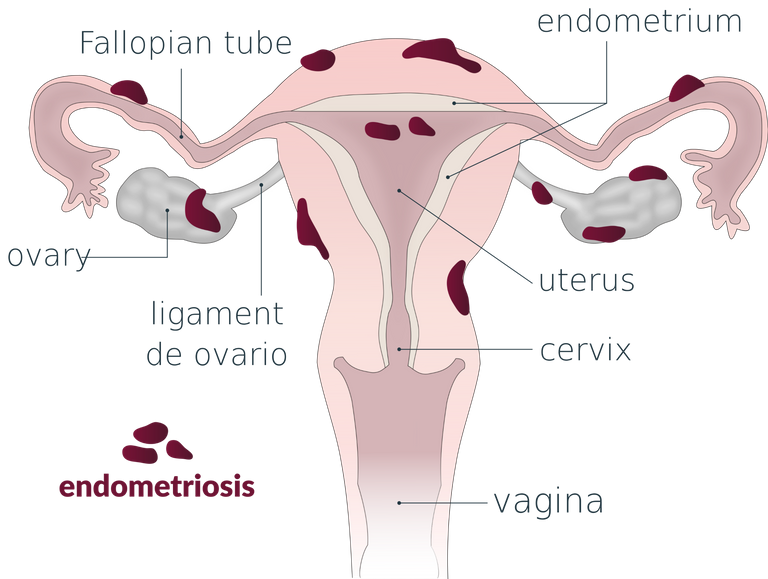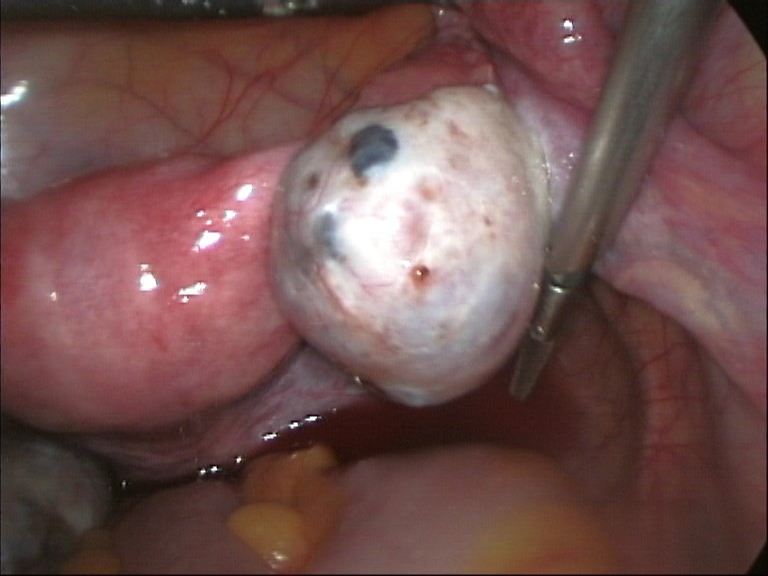ENDOMETRIOSIS

By Vega asensio - Own work, CC BY-SA 4.0, Wikimedia
Endometriosis is a medical condition that occurs when endometrial tissues are found outside the lining of the uterus. The inner cavity of a woman's womb (uterus) is lined by specialized tissues called endometrial tissues. These tissues undergo cyclical changes during the menstrual cycle which leads to the shedding of the inner wall of the uterus when there is no fertilization and implantation of an embryo. This is seen as menses.
The endometrial tissues are normally found in the endometrial cavity (inner lining of the uterus) only. When these endometrial tissues are found in other places outside the endometrial cavity, it is described as endometriosis and it is a common cause of chronic pelvic pain and infertility among women. This disease affects women of reproductive age globally and according to the World Health Organisation;
Endometriosis affects roughly 10% (190 million) of reproductive-age women and girls globally.
In endometriosis, these endometrial tissues can be found anywhere, but most commonly within the pelvis. Other sites include the pleural cavity, nasal cavity, umbilicus, or even abdominal scars. These tissues cause severe cyclical pain, bleeding, inflammation, fibrosis and adhesions at these sites which lead to reduced quality of life, school and work absenteeism, and subfertility.
The pain of endometriosis is cyclical and usually occurs around the time of menstruation. The specific symptom is dependent on the site where the endometrial tissues are found.
When the endometrial tissues are located within the pelvic cavity and the female reproductive tract, the symptoms include severe painful menstruation, severe pelvic pain, painful sexual intercourse, lower abdominal pain, and infertility.
When the endometrial tissues are located in the gastrointestinal tract, the symptoms will include cyclical bleeding from the rectum and painful defecation. When it is located in the nasal cavity, it casues a cyclical nose bleeding and pain.
The location of the endometrial tissues in the lungs will lead to a cyclical cough with bloody sputum, blood, and air in the chest cavity. When the endometrial tissues are located in the urinary tract, there will be a passage of bloody urine, painful urination, and obstruction to the flow of urine due to inflammation and fibrosis.

By Female anatomy-nb.svg:Own work , CC BY-SA 3.0, Wikimedia
The symptoms of endometriosis usually mimic other diseases, therefore there should be a high index of suspicion and clinical accuracy. An early diagnosis of endometriosis is always a life-changing moment for the woman as it will help to improve the quality of life of the woman through effective management. Endometriosis has no cure, but there are medical and surgical interventions to help manage the condition.
CAUSE OF ENDOMETRIOSIS
The cause of endometriosis is not known but many theories have been proposed to help explain this condition.
One of the theories is the theory of menstrual regurgitation or retrograde menstruation which states that endometriosis occur when blood containing endometrial cells flows back through the fallopian tubes into the peritoneal cavity. The endometrial cells attach to the peritoneal cavity and start causing the problem there.
However, this theory does not explain the location of the endometrial tissues in distant places like the nasal cavity and the lungs.
Another causative theory of this disease is the vascular and lymphatics spread which postulates that the endometrial cells are carried by blood and lymphatics to various locations. This theory explains the finding of endometriosis in distant places like the lungs and nasal cavity.
Other theories include the theory of coelomic metaplasia which postulates that cells in other locations transform and become like endometrial cells.
However, more research is still needed on this disease to determine the exact cause, progression, and effective cure for endometriosis.

By Hic et nunc - Own work, CC BY-SA 3.0, Wikimedia
ENDOMETRIOSIS AND INFERTILITY
Apart from the severe cyclical pain and bleeding, another major problem of endometriosis is infertility. Most women who have endometriosis find it difficult to conceive. For these groups of women, surgical treatment is the preferred choice of treatment as well as ovarian stimulation and in-vitro fertilization.
INVESTIGATIONS AND TREATMENT
The relevant investigations in the diagnosis of endometriosis include a transvaginal ultrasound scan, magnetic resonance imaging, or laparoscopy.
When the diagnosis is made, the choice of treatment depends on the extent of the disease and the woman's choice of conception.
The treatment of endometriosis can be medical or surgical. Medical treatment of this disease includes the use of analgesics to manage the pain. Such analgesics like Non-steroidal anti-inflammatory drugs are used. Other sets of drugs used are hormonal drugs which include combined oral contraceptive pills, progestogen, gonadotrophin-releasing hormone agonists, etc. However, some of these hormonal drugs are not suitable for women who wish to conceive.
Surgical management of endometriosis includes laparoscopic surgeries like laser vaporization and excision and in extreme cases, especially for those who have completed their family size, the definitive treatment is the surgical removal of the womb, fallopian tubes, and ovaries.

By Vulvani - Own work, CC BY-SA 4.0, Wikimedia
In conclusion, endometriosis is a common disease that affects women of reproductive age from menarche to menopause. It occurs globally and has a great impact on the sexual and reproductive well-being of women as well as their quality of life and work.
Endometriosis is a chronic condition and has no cure. The diagnosis is always missed because the symptoms of endometriosis may be unspecific and may resemble the symptoms of other diseases. Therefore, we should always have a high index of suspicion.
The diagnosis of endometriosis always brings a turnaround and improvement in the life of the woman as effective management is instituted.
It is therefore important to continue to raise awareness of endometriosis among women of reproductive age and the general population so that they can seek early medical intervention and proper management.
Thanks so much for reading.
For references and further reading on endometriosis, please contact;
Thank you my chief for this wonderful article. I have never come across the theory of menstrual regurgitation before but I can now say something about it from your lecture. Thanks once again
You're welcome Sir. I am glad that it was helpful. Thank you so much for your wonderful contribution sir. I am grateful.
You're welcome
Thanks for your contribution to the STEMsocial community. Feel free to join us on discord to get to know the rest of us!
Please consider delegating to the @stemsocial account (85% of the curation rewards are returned).
Thanks for including @stemsocial as a beneficiary, which gives you stronger support.
Thanks so much for your support @stemsocial . I am grateful
Women are really going through a lot, sometimes our body just choose to fail us
Yes, but there is always a way out of every challenge
Yes but it still a hard way.